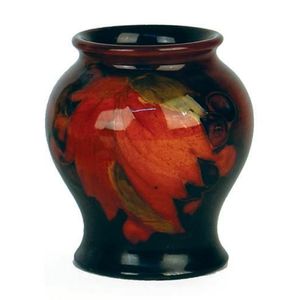
Moorcroft Flambe Wisteria Vase, Signed and Marked
William Moorcroft flambe 'Wisteria' vase, C1935, impressed mark and signed to base. Height 26.5 cm approx

Rare William Moorcroft Flambe Landscape Vase
A rare William Moorcroft flambe 'Eventide' landscape design vase, elongated ovoid form, the rich red flambe glaze over the landscape design with dominant trees. The base with full signature in blue, impressed mark and large paper label. Height 20.7 cm

Moorcroft Flambe Eventide Compressed Vase
A Moorcroft flambe Eventide Compressed vase, circa 1929, baluster with a continuous pattern of trees in a landscape, red and burnt orange ground impressed factory marks painted signature, to base, 13 cm high, slight crack to rim

Moorcroft Flambe Vase with Leaves and Berries
Moorcroft tall flambe vase decorated with leaves and berries, blue signature, 43 cm high

Moorcroft Flambe Pomegranate Vase - 32cm High
Large Moorcroft flambe pomegranate pattern vase impressed mark and green signature to base, 32 cm high

Moorcroft Flambe Friesia Vase, c.1928-1949
A William Moorcroft flambe Friesia vase, c.1928-1949, signed green/blue signature with impressed 'Potter to the Queen' and various factory marks. Height 23.3 cm

William Moorcroft Flambe Vase with Leaves and Berries
A William Moorcroft flambe leaves & berries vase, c.1928-1949 painted blue signature with impressed marks. Height 32.3 cm

Moorcroft Anemone Flambe Vase, Impressed Mark and Signature
Small Moorcroft 'Anemone' flambe vase 15.5 cm high approx. Impresed mark and signature to base

Moorcroft Flambe Poppy Vase with Signature - 26.5cm
Large Moorcroft flambe big poppy vase 26.5 cm high approx. Impressed mark and signature to base

Moorcroft Flambe Anemone Vase (24cm) with Signature
Large Moorcroft flambe anemone vase 24 cm high. William Moorcroft signature to base.

Rare Large Flambe Moorcroft Dawn Landscape Vase
Very rare large Moorcroft Dawn landscape vase with bright flambe glaze. 33 cm high.

Moorcroft Flambe Vase - Signed & Marked - 13cm Height
Moorcroft flambe vase with signature & impressed Moorcroft mark. Height 13 cm

Moorcroft Flambe Vase with Leaves and Berries
A William Moorcroft Pottery, leaves and berries flambe vase c.1928 - 1949. Signed with impressed factory marks. Height 17.3 cm

Moorcroft Flambe Spherical Vase with Orchids & Spring Flowers
Moorcroft: 'Orchids & Sping Flowers' flambe spherical vase, late 1930's. 10 cm.

Rare Flambe Glazed Moorcroft Leaf & Berry Vase
William Moorcroft leaf & berry vase. C.1930 with rare flambe glaze. Height 13 cm

Moorcroft flambe leaf and berry vase
William Moorcroft leaf & berry posy vase. C.1930 with rare flambe glaze. Height 11 cm

Moorcroft Flambe Anemone Vase
A Walter Moorcroft squat baluster anemone vase, flambe glaze to the red, blue, green and yellow toned florals, the ground graduating from red to blue. Initials in blue and impressed marks to base. Height 12.8 cm

Pre-1939 Moorcroft Orchids Flambe Vase
Moorcroft Orchids vase, flambe wash, William Moorcroft pre 1939

Moorcroft Waratah Flambe Vase - 1930s
A William Moorcroft flambe waratah vase, circa 1930, the compressed baluster body painted with flowering Waratah on a rich red ground, 15 cm high, signed in blue 'W.Moorcroft' impressed facsimile signature and 'Potter to HM The Queen'

William Moorcroft Flambe Vase, 20 cm Height, Signed
Moorcroft flambe vase signed William Moorcroft to base. Height 20 cm

William Moorcroft Flambe Leaf and Berry Vase
A small William Moorcroft flambe Leaf and Berry vase, inverted baluster form, impressed and signature marks to base. 4.5 x 8.5 cm

Moorcroft Flambe Peacock Feather Vase - 1920s Beauty
A good Moorcroft flambe peacock feather vase circa 1920's. Height 20 cm



 Loading more...
Loading more...